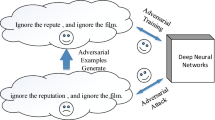Abstract
Adversarial examples are artificially modified input samples which lead to misclassifications, while not being detectable by humans. These adversarial examples are a challenge for many tasks such as image and text classification, especially as research shows that many adversarial examples are transferable between different classifiers. In this work, we evaluate the performance of a popular defensive strategy for adversarial examples called defensive distillation, which can be successful in hardening neural networks against adversarial examples in the image domain. However, instead of applying defensive distillation to networks for image classification, we examine, for the first time, its performance on text classification tasks and also evaluate its effect on the transferability of adversarial text examples. Our results indicate that defensive distillation only has a minimal impact on text classifying neural networks and does neither help with increasing their robustness against adversarial examples nor prevent the transferability of adversarial examples between neural networks.
Access this chapter
Tax calculation will be finalised at checkout
Purchases are for personal use only
Similar content being viewed by others
Notes
- 1.
The software used for the experiments can be found online at https://github.com/Top-Ranger/text_adversarial_attack.
References
AG’s corpus of news articles. http://www.di.unipi.it/~gulli/AG_corpus_of_news_articles.html. Accessed 27 Oct 2017
Akhtar, N., Mian, A.: Threat of adversarial attacks on deep learning in computer vision: a survey. IEEE Access 6, 14410–14430 (2018). https://doi.org/10.1109/ACCESS.2018.2807385
Brendel, W., Bethge, M.: Comment on “biologically inspired protection of deep networks from adversarial attacks”. CoRR abs/1704.01547 (2017)
Carlini, N., Wagner, D.A.: Defensive distillation is not robust to adversarial examples. CoRR abs/1607.04311 (2016)
Fellbaum, C. (ed.): WordNet: An Electronic Lexical Database. MIT Press, Cambridge (1998)
Goodfellow, I.J., Shlens, J., Szegedy, C.: Explaining and harnessing adversarial examples. In: International Conference on Learning Representations (2015)
Hinton, G., Vinyals, O., Dean, J.: Distilling the knowledge in a neural network. In: NIPS Deep Learning Workshop (2014)
Jia, R., Liang, P.: Adversarial examples for evaluating reading comprehension systems. In: Proceedings of the Conference on Empirical Methods in Natural Language Processing, pp. 2021–2031 (2017). https://doi.org/10.18653/v1/D17-1215
Kim, Y.: Convolutional neural networks for sentence classification. In: Proceedings of the Conference on Empirical Methods in Natural Language Processing, pp. 1746–1751 (2014)
Leskovec, J., Krevl, A.: SNAP datasets: stanford large network dataset collection. http://snap.stanford.edu/data (2014)
Liang, B., Li, H., Su, M., Bian, P., Li, X., Shi, W.: Deep text classification can be fooled. In: Proceedings of the International Joint Conference on Artificial Intelligence, pp. 4208–4215 (2018). https://doi.org/10.24963/ijcai.2018/585
Lu, J., Issaranon, T., Forsyth, D.: SafetyNet: detecting and rejecting adversarial examples robustly. In: IEEE International Conference on Computer Vision, pp. 446–454 (2017). https://doi.org/10.1109/ICCV.2017.56
McAuley, J.J., Leskovec, J.: From amateurs to connoisseurs: modeling the evolution of user expertise through online reviews. In: Proceedings of the International Conference on World Wide Web, pp. 897–908 (2013). https://doi.org/10.1145/2488388.2488466
Mikolov, T., Chen, K., Corrado, G., Dean, J.: Efficient estimation of word representations in vector space. In: International Conference on Learning Representations (2013)
Mikolov, T., Sutskever, I., Chen, K., Corrado, G.S., Dean, J.: Distributed representations of words and phrases and their compositionality. In: Advances in Neural Information Processing Systems, pp. 3111–3119 (2013)
Mitton, R.: Corpora of misspellings for download. http://www.dcs.bbk.ac.uk/~ROGER/corpora.html. Accessed 10 Nov 2017
Nayebi, A., Ganguli, S.: Biologically inspired protection of deep networks from adversarial attacks. CoRR abs/1703.09202 (2017)
Papernot, N., McDaniel, P., Wu, X., Jha, S., Swami, A.: Distillation as a defense to adversarial perturbations against deep neural networks. In: IEEE Symposium on Security and Privacy, pp. 582–597 (2016). https://doi.org/10.1109/SP.2016.41
Papernot, N., McDaniel, P.D.: Extending defensive distillation. CoRR abs/1705.05264 (2017)
Papernot, N., McDaniel, P.D., Sinha, A., Wellman, M.P.: Towards the science of security and privacy in machine learning. CoRR abs/1611.03814 (2016)
Rozsa, A., Gunther, M., Boult, T.E.: Towards robust deep neural networks with bang. In: IEEE Winter Conference on Applications of Computer Vision, pp. 803–811 (2018). https://doi.org/10.1109/WACV.2018.00093
Samanta, S., Mehta, S.: Towards crafting text adversarial samples. CoRR abs/1707.02812 (2017)
Su, J., Vargas, D.V., Sakurai, K.: One pixel attack for fooling deep neural networks. IEEE Trans. Evol. Comput. (2019). https://doi.org/10.1109/TEVC.2019.2890858
Szegedy, C., et al.: Intriguing properties of neural networks. In: International Conference on Learning Representations (2014)
Tramèr, F., Kurakin, A., Papernot, N., Boneh, D., McDaniel, P.: Ensemble adversarial training: attacks and defenses. In: International Conference on Learning Representations (2018)
Tramèr, F., Papernot, N., Goodfellow, I., Boneh, D., McDaniel, P.: The space of transferable adversarial examples. CoRR abs/1704.03453 (2017)
Zhang, W.E., Sheng, Q.Z., Alhazmi, A.A.F., Li, C.: Generating textual adversarial examples for deep learning models: a survey. CoRR abs/1901.06796 (2019)
Zhang, X., Zhao, J., LeCun, Y.: Character-level convolutional networks for text classification. In: Advances in Neural Information Processing Systems, pp. 649–657 (2015)
Zhang, Y., Wallace, B.: A sensitivity analysis of (and practitioners’ guide to) convolutional neural networks for sentence classification. In: Proceedings of the International Joint Conference on Natural Language Processing, pp. 253–263 (2017)
Acknowledgments
The authors gratefully acknowledge partial support from the German Research Foundation DFG under project CML (TRR 169) and the European Union under project SECURE (No 642667). The following software libraries were used for this work: Keras, Tensorflow, Gensim, NLTK with the WordNet interface, and NumPy.
Author information
Authors and Affiliations
Corresponding author
Editor information
Editors and Affiliations
Rights and permissions
Copyright information
© 2019 Springer Nature Switzerland AG
About this paper
Cite this paper
Soll, M., Hinz, T., Magg, S., Wermter, S. (2019). Evaluating Defensive Distillation for Defending Text Processing Neural Networks Against Adversarial Examples. In: Tetko, I., Kůrková, V., Karpov, P., Theis, F. (eds) Artificial Neural Networks and Machine Learning – ICANN 2019: Image Processing. ICANN 2019. Lecture Notes in Computer Science(), vol 11729. Springer, Cham. https://doi.org/10.1007/978-3-030-30508-6_54
Download citation
DOI: https://doi.org/10.1007/978-3-030-30508-6_54
Published:
Publisher Name: Springer, Cham
Print ISBN: 978-3-030-30507-9
Online ISBN: 978-3-030-30508-6
eBook Packages: Computer ScienceComputer Science (R0)




